In the garden of Dee’s Tots Childcare, amid the sunflowers, cornstalks, and plastic cars, a three-year-old girl with beads in her braids and a two-year-old blond boy are shimmying. These are Deloris Hogan’s 6:45 p.m. pick-ups. Nearby, also dancing, are four kids who won’t be picked up until late at night, as well as two “overnight babies,” as Deloris calls them. Dee’s Tots stays open 24 hours a day, seven days a week; the children’s parents work unconventional hours, producing an unexpected cycle of drop-offs and reunions. One afternoon in August, the kids bounce on the center’s inflatable castles, rustle around at the sand tables, and eat a watermelon snack. Then it gets dark.
By 8:30 p.m., three-year-old Naima is in her pink polka-dot pajamas. Little Ivette and her watchful older sister, Diana, lie down on thin mattresses laid over yoga mats. Even with the lights dimmed, you can make out the bright posters on the wall, the costumes and the boxes of dolls and baby clothes, and the fluttering rainbow curtain dividing one of the rooms from the other. Aladdin is playing in the background; the Genie riffs. Deloris changes two-year-old Kaden’s diaper; next, she’ll give one-year-old Noah a bath. Watching the bedtime endgame at what might be called “extreme daycare” can be fretful. I fear that even efficient, poised Deloris won’t be able to wash all the kids in time for bed, and that I’ll have to keep myself from herding her wards to the bathroom and to their pallets. What if the children turn into tear-stained goblins of exhaustion before Deloris gets them tucked in? How will she manage it?
The main room at Dee’s Tots looks like a supersized slumber party, but the truth is this is an ordinary day. Dee’s is only one of a number of 24-hour child care centers around the country. Just on this single block in New Rochelle, New York, there’s another facility, Little Blessings, that offers overnights as well. Little Blessings and Dee’s are in a nearly comic decoration-off, competing for kids with colored lights, giant Doras, and Spider-Men. Some round-the-clock centers play more toward parents, with aspirational names like Success Kidz 24 Hour Enrichment Center.
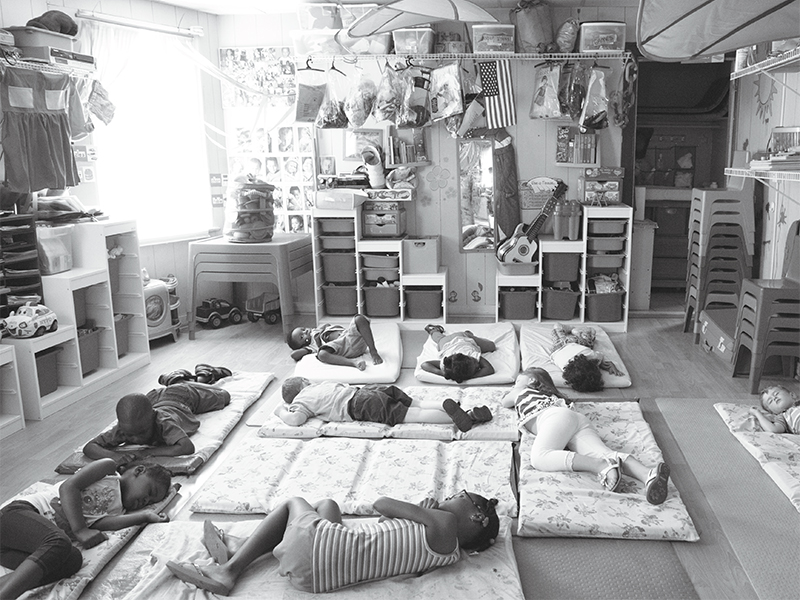
(Photo: Alice Proujansky)
The growth of this industry makes sense: We now have an expanded workweek, often composed of unpredictable hours. Nearly 40 percent of Americans have non-standard work lives. (The average American adult also now works one and a quarter jobs.) Working people who live below the poverty line are particularly afraid to say no to these unusual schedules. They may have no one to say no to, anyway—those schedules might have been created by computers, rather than human managers, in the hopes of saving a corporation money. Many companies now use data and algorithms to schedule employees so fewer hours will be spent sitting around. The software doesn’t care if a shift falls in the middle of the night, or that it might tear a big hole in an employee’s family life.

Well-paid professionals who work evenings may be able to afford one or two nannies, or they may have partners who stay at home. But parents like the ones who rely on Dee’s can’t afford such luxuries. Diana and Ivette’s mother, Marisol, for instance, is raising the girls on her own, working at a supermarket from 8 a.m. until 2 p.m. and at Home Depot from 6 to 10 p.m., six days a week. The girls are at the Hogans’ for both of her shifts, and she’s with them between 2:30 and 5:30 p.m. each day. “I worked one job 29 hours a week, so I got a second job, as I can’t afford to take care of my kids—I need more money to be surviving,” says Marisol, a slim young woman with glasses and pulled-back hair who came to the U.S. from Mexico when she was four. Marisol works 29 hours at each of her jobs. This is common. If an employee works more hours, her employer is required to provide health insurance. “With car payments coming up, I applied for Home Depot,” she says. “The Hogans are very open about my schedule and were willing to work with me.”
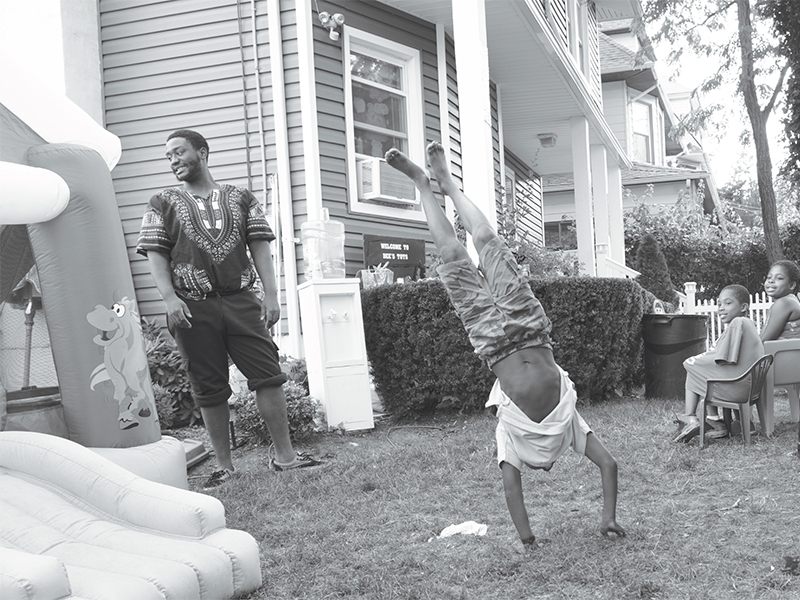
(Photo: Alice Proujansky)
Marisol misses a lot of her kids’ growing up—a particularly difficult reality since she feels she has to do these extra jobs for them. One afternoon, I see her at Dee’s Tots carrying in a tray of chocolate-frosted cupcakes with pink decorations for Ivette to celebrate her fourth birthday with her day- and night-care friends. “When I pick them up they should be sleeping; I have to wake them up. With the little one it’s easy, but the older one….” Marisol trails off.

Deloris and her husband, Patrick Hogan, who co-own the center, have nicknames for all the kids—Chowder, K.K., Little Bit, Jelly. Most see Patrick and Deloris, whom the kids call Nunu, more than they see their parents.
The Hogans started this daycare in 1985 in order to earn a living while looking after their own young children. Now Deloris and Patrick, ages 53 and 58 respectively, work around the clock. Both go to bed around 1 or 2 a.m. Deloris then wakes up again if one of the overnight babies needs attention. She goes back to sleep and Patrick wakes up at 5:45 a.m. He makes breakfast for the overnight babies and prepares the house for the 6 a.m. drop-offs. (Nobody comes or goes at Dee’s Tots between 3 and 6 a.m.)*

(Photo: Alice Proujansky)
Deloris and Patrick met in 1974, in the housing projects across town from the home they now own. Patrick was raised by his mother; his father, a prizefighter and a fry cook, was not around much. Deloris was raised in rural Mississippi by both her parents, who picked cotton and tobacco on former plantations. Deloris and Patrick have been together for 40 years. They are proud of their four children, some of whom have already graduated college and embarked on their own professional lives. They are also proud of Dee’s. Patrick wears hospital scrubs in many different colors—red, blue, purple, yellow, tan—as a sort of professional uniform. “It’s good for branding,” he says. (To his delight, he is also sometimes mistaken for a doctor.) Occasionally, his pride in his work has an edge, as when he serves the kids food and jokes with them—“Six dollars, please,” as if he were a waiter and these children were his clients. Which, in a sense, they are. I ask him if he ever tires of his extreme work schedule.
“Would I enjoy not working? Yes,” he says. “But who wouldn’t?”
Six months in advance, the Hogans prepare, for the parents of the kids they watch, a list of days that Dee’s Tots will be closed. Fifteen hours are for job training required by the state, and each year they go away for their anniversary, but they don’t always take off for Thanksgiving. “The stores and the nurses are not off for Thanksgiving,” Deloris says. Still, her caretaking commitment, so ample that she offers me tips for getting my own daughter off bottles, has its limits. Recently, one child’s mother was asked to work a shift starting at 3:30 a.m. The mother asked the Hogans if she could drop off her child around that time; the answer was no.**
The Hogans understand that they are in a symbiotic relationship with the children’s parents, and that the children’s well-being, as well as their own financial security, depends on their providing around-the-clock nurturance. The demand for this kind of extreme daycare will only grow as nursing jobs, for instance, rise. (According to the Bureau of Labor Statistics employment projections, registered nursing is one of the occupations that will see the most growth through 2022, due to a large aging population.) Hospitals and conglomerates force irregular hours onto their lowest-paid workers, sometimes without sensitivity to workers’ needs. Consumers, too, play a role. We assume that we should be able to buy or eat whatever we want, whenever we want, even in the middle of the night.
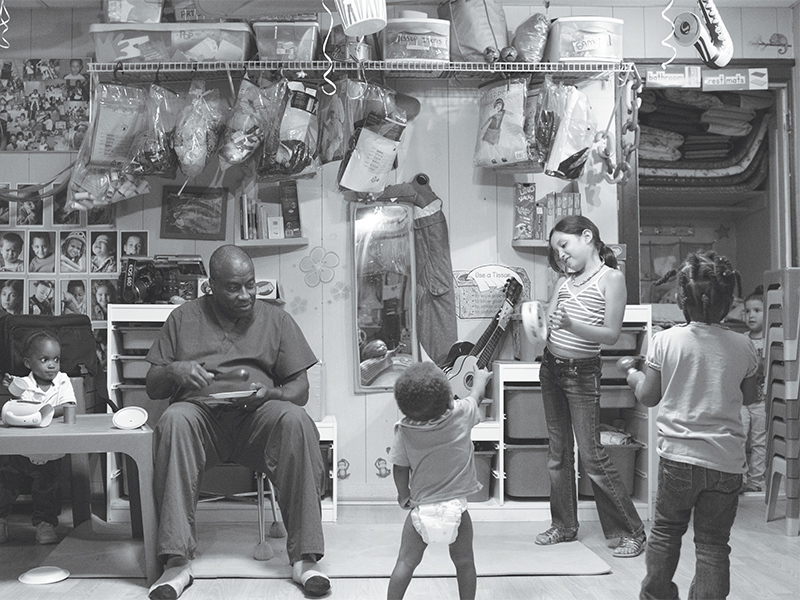
(Photo: Alice Proujansky)
So what is a parent who needs to drop off her kid at 3:30 a.m. supposed to do? “It was all about 9-to-5 daycare 10 years ago,” says Deloris. “But now that the stores are open till 12 at night or even 24 hours a day, we are needed. We have to do this.” Soon somebody, if not Deloris, will open a business to accommodate the 3:30 a.m. drop-offs.
Ours is a forever clock.

Twenty-four-hour daycare can seem shocking to people who have no need for it. When I mentioned extreme daycare to some middle-class parents—some of them parents much like me—a number recoiled at the thought. These same parents have their own children full time at tonier daycare centers or with a nanny. They also often work far into the night themselves, laptops aglow, making their dimly lit homes look like aquariums. Yet many found it strange to have a child at a facility overnight. A number were surprised that such places even exist.
Of course, bathing or wrapping a blanket around a child is intimate and can seem like the most important moment in the day. Yet many Americans now can’t necessarily choose when to work and when to parent.
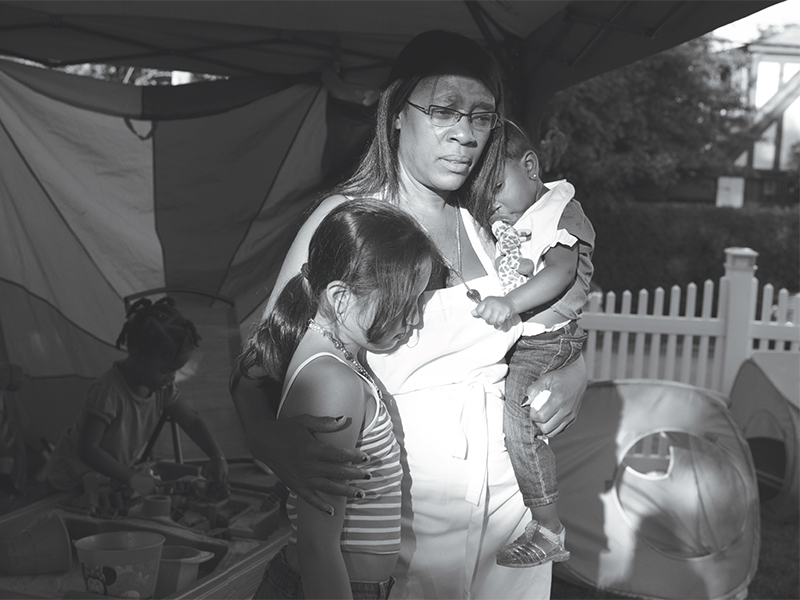
(Photo: Alice Proujansky)
Take Kaden’s mother. She is a single mom who works at Costco until 10:30 p.m. Her two-year-old is so well behaved that he washes his hands at the daycare’s play-kitchen sink before cooking his play food. But Kaden’s family situation is even more complex than Marisol’s. Many days, Kaden’s aunt picks him up at another daycare center and drops him at Dee’s. He is also living on the forever clock.
This clock has highlighted weakness in our social networks. In 2013, 28 percent of children were living with a single parent; 77 percent of those single parents are mothers. Even mothers who have the support of family and friends may have strained those relationships to the breaking point. When single parents are struggling economically, scholars have found, they rely greatly on their closest kith and kin for support—far more so than their wealthier counterparts. And while that reliance can breed intimacy, being 30 percent more reliant on your friends and family (as single parents are, according to one study) can also backfire. As Rosanna Hertz, a sociology professor at Wellesley College who studies working single mothers, notes, social networks “depend on reciprocity. But if you are working all those hours, what can you reciprocate? You can’t offer your neighbors or your sister much; you’ve overspent your welcome.”
Public daycare networks aren’t so strong, either. They’re consistently underfunded, and attempts to strengthen the programs are incomplete. For example, in New York City, the new, progressive mayor Bill de Blasio is implementing universal pre-K. But pre-K is only one year, and only operates Monday to Friday. What about the four years before? What about evenings and weekends? “Pre-K is not necessarily going to cover all the hours that parents must work, and it’s a patchwork,” says New York University sociologist Kathleen Gerson. “If you have to work the night shift or seven days a week, what are you going to do?”
For families that qualify for assistance, the state pays the Hogans up to $250 per child per week. A few families can afford to pay that rate in full themselves, but, says Patrick, most are paying only $1 to $5 a day. The state makes up the rest. Working with the social welfare system is not easy. In 2008, Patrick joined a relatively new New York state union of daycare providers (under the umbrella of the large Civil Service Employees Association), in part to fight what he perceives as draconian bureaucracy. Rules now dictate that paper towels must be available at all times. Gloves must be worn if food is being served—or even just handed—to kids. Running out of paper towels can result in a daycare being shut down.
Still, Dee’s is far from drearily institutional. On one of my visits, giant puffy pencils and teddy-bear balloons are hanging from the front fence and kids are jumping on a bouncy house, giving the place a touch of the carnival. At twilight, two children help Deloris water her cucumber and melon plants while keeping their eyes out for plundering raccoons.
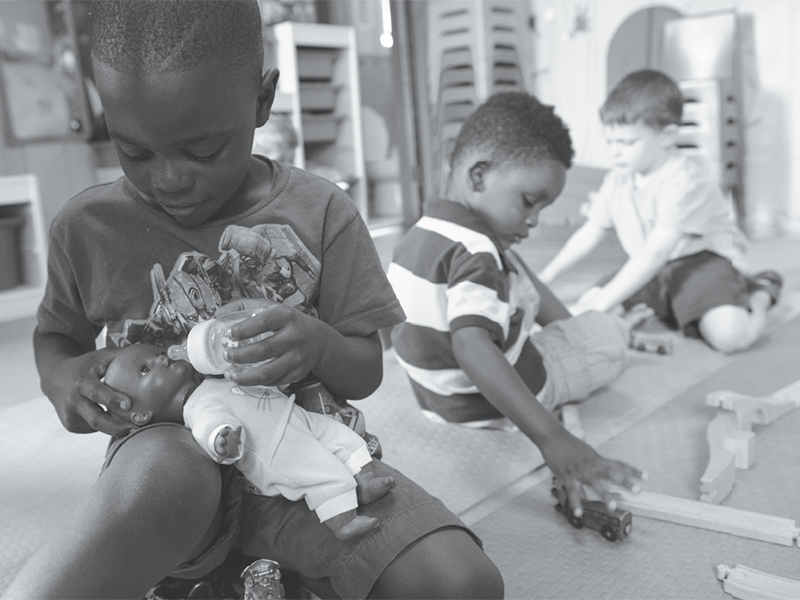
(Photo: Alice Proujansky)
Dee’s Tots does not focus on education. The Hogans work a bit with preschoolers on the alphabet and numbers, but hours are typically consumed playing with dolls and their dresses, throwing and kicking plastic balls, engaging in sing-alongs, or dancing to R&B hits or “The Cha Cha Slide.” In short, it’s perfect for four-year-olds, but not necessarily what fifth graders need after school. But these 24-hour kids seem all right, if unusually self-sufficient. One night, Diana, Marisol’s eight-year-old daughter, showed me how to perfectly squeeze toothpaste out of the tube like in a commercial. Her four-year-old sister, Ivette, brushed her own teeth without being asked. I saw little of the sorrow or loneliness that one might expect to see in these kids, though I did catch ripples of uncertainty and need. A few of the children seemed “parentified,” in the useful but awkward psychology parlance—wise beyond their years. One night, the Hogans played the film Coraline, a dark fantasy about a child whose real mother is replaced by a fake one, replete with buttons for eyes. One of the kids turned to me and said, “Why do children think parents are going to save them?” She paused. “That’s stupid.”
*Update—November 12th, 2014: Due to an editing error, we misstated Deloris’ sleeping schedule. She wakes up in the middle of the night not at 3:00 a.m. but whenever one of her overnight babies needs care.
**Update—November 12th, 2014: We originally wrote that the state requires 15 days of job training annually. It requires 15 hours.
This article and photographs were supported by the Economic Hardship Reporting Project, a non-profit devoted to journalism about inequality.





